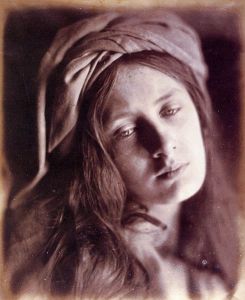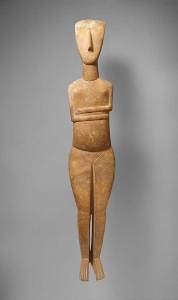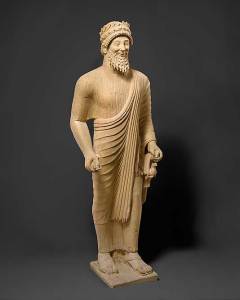When her father first visited her in New York, my cousin told me, he spent three days exploring the Met, alone. The next time he made the journey, he did the same. We hurried off 5th Avenue and into the warmth of the museum’s foyer. ‘Is it because there’s a lot of stuff to see?’ I asked, ‘Or because the stuff is worth looking at for a long time?’ ‘Both, I think’, she replied.

Beatrice Cenci (1866), Julia Margaret Cameron
We paid for our entry and asked the cashier for directions to the Julia Margaret Cameron exhibition. Julia Margaret Cameron was a photographer in the 19th century: the images on the posters had an ethereal quality that evoked not only Victorian spiritualism – the zeit that was entranced by the geist – but also, perhaps, the fact that back then cameras were generally less precise than we’re used to today.
We got lost before we’d left the ground floor. It was my fault – I was distracted by the room of Cycladic figures to the left of the entrance. It would be easy to assume that they were the creations of some modernist sculptor – broad-shouldered bodies carved in pale stone, each face abstracted to a wide triangular plain with a single peak for the nose. The Met had all those I’d pored over during my undergraduate archaeology course, thrilled at their anachronistic simplicity and apparent softness. Seeing them ‘in the flesh’ was like walking into a party and realising I was surrounded by 20 of the most famous people in the world.

Marble female figure, (early Cycladic II), attributed to the Bastis Master. Gift of Christos G. Bastis
Finding them in a museum of art caught me off-guard. In the UK, I’d have to go to the British Museum to see similar pieces, curatorially sorted into civilizations and sodden with colonial history. In London recently, several major shows that have made an effort to blur the boundaries between art and artefact – the British Museum’s ‘Ice Age art’ exhibition; Grayson Perry’s ‘Tomb of the Unknown Craftsman’ at the same place; the Royal Academy’s ‘Bronze’; Tate’s ‘Art Under Attack’ – but the distinction between these two categories remains cemented in the bricks-and-mortar institutions themselves.
These shows have been illuminating, but not always entirely successful. Their effectiveness is dependent on a curatorial sensitivity to the three-way relationship between the exhibited objects, the institution, and the way that both are viewed by a broader audience.
Grayson Perry riffed on this magnificently in the ‘Tomb of the Unknown Craftsman’. Set alongside his own works, artefacts from the British Museum’s collection were brought back to life: veils of obscure information such as date, civilization and ‘possible use’ were set aside. The show allowed us to look at each object not as representative of a particular culture or epoch, but as something that had been physically shaped by a person, for other people to look at. The artist Ian Kiaer, in Picpus, described a similar experience in response to the miniscule carvings in the museum’s ‘Ice Age art’ exhibition: ‘I imagine them for the most part to remain wrapped and held close; dark objects, hidden until it is safe to bring them out for the most intense looking’.
The Met seemed to have the same effect. It distilled my perception of the Cycladic sculptures, allowing me to look through the sediment of archaeological conjecture that usually buries them, and see them as art. This might not be the way they were viewed at the time they were created, but it felt human, and I enjoyed it.

Limestone statue of a bearded man with votive offerings. Cypriot, (c. 475–450 BC) The Cesnola Collection, Purchased by subscription, 1874–76
My cousin pulled me away: she wanted to find Julia Margaret Cameron. By now, we’d forgotten the directions we’d been given when we came in, and ended up in a labyrinth of paintings somewhere on an upper floor. Here, pictures recalled the ancient works by the entrance. Toulouse-Lautrec’s Streetwalker looked out from the frame with not only the same expression, but the same hat as a Cypriot sculpture I’d seen near the Cycladic room: the Met invoked thousands of years of artistic continuity simply by placing the two pieces under the same roof.
After another hour, we searched again for the photography exhibition, finding it only a short while before the museum closed. I thought back to my uncle’s solitary expedition, and decided that he must be a very prudent man.

Well Met
Limestone statue of a bearded man with votive offerings. Cypriot, (c. 475–450 BC) The Cesnola Collection, Purchased by subscription, 1874–76
Share
When her father first visited her in New York, my cousin told me, he spent three days exploring the Met, alone. The next time he made the journey, he did the same. We hurried off 5th Avenue and into the warmth of the museum’s foyer. ‘Is it because there’s a lot of stuff to see?’ I asked, ‘Or because the stuff is worth looking at for a long time?’ ‘Both, I think’, she replied.
Beatrice Cenci (1866), Julia Margaret Cameron
We paid for our entry and asked the cashier for directions to the Julia Margaret Cameron exhibition. Julia Margaret Cameron was a photographer in the 19th century: the images on the posters had an ethereal quality that evoked not only Victorian spiritualism – the zeit that was entranced by the geist – but also, perhaps, the fact that back then cameras were generally less precise than we’re used to today.
We got lost before we’d left the ground floor. It was my fault – I was distracted by the room of Cycladic figures to the left of the entrance. It would be easy to assume that they were the creations of some modernist sculptor – broad-shouldered bodies carved in pale stone, each face abstracted to a wide triangular plain with a single peak for the nose. The Met had all those I’d pored over during my undergraduate archaeology course, thrilled at their anachronistic simplicity and apparent softness. Seeing them ‘in the flesh’ was like walking into a party and realising I was surrounded by 20 of the most famous people in the world.
Marble female figure, (early Cycladic II), attributed to the Bastis Master. Gift of Christos G. Bastis
Finding them in a museum of art caught me off-guard. In the UK, I’d have to go to the British Museum to see similar pieces, curatorially sorted into civilizations and sodden with colonial history. In London recently, several major shows that have made an effort to blur the boundaries between art and artefact – the British Museum’s ‘Ice Age art’ exhibition; Grayson Perry’s ‘Tomb of the Unknown Craftsman’ at the same place; the Royal Academy’s ‘Bronze’; Tate’s ‘Art Under Attack’ – but the distinction between these two categories remains cemented in the bricks-and-mortar institutions themselves.
These shows have been illuminating, but not always entirely successful. Their effectiveness is dependent on a curatorial sensitivity to the three-way relationship between the exhibited objects, the institution, and the way that both are viewed by a broader audience.
Grayson Perry riffed on this magnificently in the ‘Tomb of the Unknown Craftsman’. Set alongside his own works, artefacts from the British Museum’s collection were brought back to life: veils of obscure information such as date, civilization and ‘possible use’ were set aside. The show allowed us to look at each object not as representative of a particular culture or epoch, but as something that had been physically shaped by a person, for other people to look at. The artist Ian Kiaer, in Picpus, described a similar experience in response to the miniscule carvings in the museum’s ‘Ice Age art’ exhibition: ‘I imagine them for the most part to remain wrapped and held close; dark objects, hidden until it is safe to bring them out for the most intense looking’.
The Met seemed to have the same effect. It distilled my perception of the Cycladic sculptures, allowing me to look through the sediment of archaeological conjecture that usually buries them, and see them as art. This might not be the way they were viewed at the time they were created, but it felt human, and I enjoyed it.
Limestone statue of a bearded man with votive offerings. Cypriot, (c. 475–450 BC) The Cesnola Collection, Purchased by subscription, 1874–76
My cousin pulled me away: she wanted to find Julia Margaret Cameron. By now, we’d forgotten the directions we’d been given when we came in, and ended up in a labyrinth of paintings somewhere on an upper floor. Here, pictures recalled the ancient works by the entrance. Toulouse-Lautrec’s Streetwalker looked out from the frame with not only the same expression, but the same hat as a Cypriot sculpture I’d seen near the Cycladic room: the Met invoked thousands of years of artistic continuity simply by placing the two pieces under the same roof.
After another hour, we searched again for the photography exhibition, finding it only a short while before the museum closed. I thought back to my uncle’s solitary expedition, and decided that he must be a very prudent man.
Unlimited access from just $16 every 3 months
Subscribe to get unlimited and exclusive access to the top art stories, interviews and exhibition reviews.
Share
Recommended for you
Affordable Art
A new 50p piece, designed by Tom Phillips to celebrate the centenary of Benjamin Britten’s birth, attempts to ‘set the wild echoes flying’
Missing Genius
Castiglione’s works at the Queen’s Gallery skilfully emulate, but never quite live up to, those of his more famous contemporaries
An Enlightening Show
‘Yoga: The Art of Transformation’ at the Arthur M. Sackler Gallery takes an overdue look at the subject in art. Its powerful yogini statues steal the show